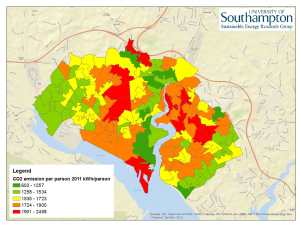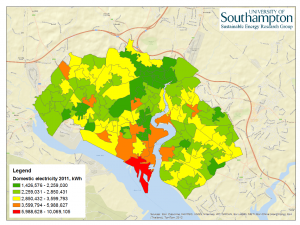Title: Low Carbon City Strategy Researcher: Yue Wu Supervisors: AbuBakr Bahaj and Luke Blunden
Abstract
GHG emissions are becoming a global concern. The UK has legally bound a CO2 emission reduction target that by 2050 at least 80% of GHG emission shall be reduced based on the emission level of 1990. Consequently, the local authorities also published their own CO2 reduction pathways, in which the city of Southampton also aims to reduce at least 80% of CO2 emission by 2050, based on 1990 level.
At the first glance, the emission performance of Southampton city seems good, as the per capita CO2 emission of Southampton is below the average of the UK, and an 11.5% emission reduction has been achieved from 2005 to 2011. However, the challenges of the 80% long-term target have been increasingly realised. For example, it was previously proposed that after 2016 all newly established houses in the UK shall be ‘zero carbon’. But then it has been proved that without a range of off-site measures to support, this proposal is barely possible to achieve. Moreover, demonstrated by Shell, the current energy-related regulations around the world are still far too slow to help the globe avoid the emission crisis, and ‘… a failure to reduce emissions now will mean considerably greater cost in the future’.
Realising the challenges, the first thing we should do is to have a sensible plan, in which the city-level emission reduction programmes can unfold smoothly, practically, and economically.
Like Southampton, many other cities have also carried out studies in carbon reduction. In the UK, Bristol, Coventry, Plymouth, Cardiff and Glasgow are the leading cities in this area, whereas, overseas, Copenhagen, Vancouver, Stockholm, Oslo, and Hamburg give good samples to study.



